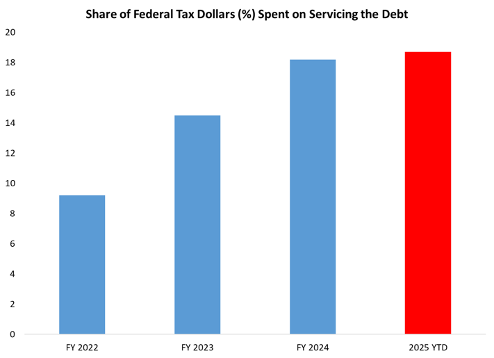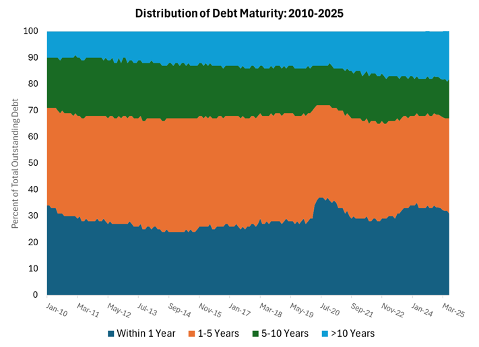The Quarterly Ledger: A Review of the Nation’s Balance Sheet: Q3 FY2025
With the recent signing into law of the One Big Beautiful Bill Act (OBBBA) slated to add over $3 trillion to the national debt through 2034, it would be valuable for policymakers to take stock of the nation’s balance sheet. Nine months into fiscal year 2025, debt held by the public reached $29 trillion. This is an increase of roughly $1.4 trillion from the same time last year, or an increase of about $8,600 per federal taxpayer.
While this update focuses on the third quarter of FY 2025, it is worth noting that the OBBBA lifted the debt ceiling, triggering a spike in newly issued debt that is expected to continue into the fourth quarter. For example, between June 27 and July 8, debt held by the public surged by $360 billion — in just 11 days. Since January, the Treasury had been using extraordinary measures, meaning maturing debt could be refinanced, but no new net debt could be issued. The short-term spike in recent weeks is the result of the Treasury ramping up short-term bill issuance with the end of extraordinary measures.
As a share of gross domestic product (GDP), the public debt ratio is 97%, or over 98% if we include the recently issued new debt since the passing of OBBBA. The public debt ratio is on track to reach the second highest level on record in 2025 (the highest level was in 1946 at 106%), and the Congressional Budget Office (CBO) forecasts our debt trajectory will reach a record high within the next four years.
At this level of public debt, the U.S. economy forgoes about 0.3 percentage points in potential economic growth based on a synthesis of over 170 estimates in the empirical literature (study forthcoming). In other words, real economic growth in 2025 would be about 1.7% rather than the forecasted 1.4% if our debt ratio was stable at 75% of GDP.
Three quarters into the fiscal year, the federal government has spent a total of $5.35 trillion, while bringing in a total of $4 trillion in receipts, according to the latest Monthly Treasury Statement. Federal revenues are slightly higher than in prior years, but spending is also higher than in prior years. As a result, the budget deficit for the first nine months of FY 2025 already exceeds $1.3 trillion. As figure 1 shows, this nine-month budget deficit is similar in size to prior years.
Figure 1.
Interest Rates and Interest Payments
One major federal outlay that has played a key role in driving spending levels higher in recent years is the growing burden of federal interest payments on the debt. Over the past 12 months, the average interest rate on U.S. government debt as a share of GDP has hovered around 3.2%. This is significantly higher than the 2001–2021 average of 1.76%. As both the public debt ratio and the interest rate on U.S. Treasuries move higher, interest expenses crowd out a larger share of the federal budget, leaving less revenue to be distributed to other policy goals and programs. More than this, the larger budget deficit also crowds out economic growth by reducing private savings and investment.
Figure 2.
As interest rates and subsequent interest payments continue on an upward trajectory, a larger share of federal revenue is spent on servicing the debt. Figure 3 below shows that year-to-date almost 19 cents in every dollar of tax revenues collected was spent on servicing the debt. This is up from 18 cents in 2024, 15 cents in 2023, and 9 cents in 2022. In other words, we’re currently spending about twice the share of tax revenue on servicing the public debt than we were less than three years ago.
Figure 3.
Maturity Structure of Public Debt
The maturity structure of public debt is a critical indicator of fiscal risk, revealing how soon the government must refinance its obligations and how vulnerable it is to changes in interest rates. The U.S. debt maturity structure is relatively short-term, meaning most of the debt is regularly rolled over into short-to-medium-term Treasuries. Figure 4 below shows the average maturity of public debt over time since 2000. This data is sourced from the latest Quarterly Refunding Documents (Treasury Dept). Historically, the average maturity of U.S. public debt is 64 months, or roughly five years, fluctuating between a low of 49 months and a high of 75 months. Looking at the most recent quarterly data (April-June), the average debt maturity is 72 months, or six years — this is one month higher than the last quarter.
Figure 4.
Looking at the distribution of public debt by different maturities, we can see almost a third of all public debt matures within one year or less, while slightly more than a third matures within one to five years. Figure 5 below reveals that the debt maturity distribution has changed very little over time, with about 70% of debt maturing within five years consistently over time. The share of public debt with a maturity of more than ten years has increased slightly, while the share with a maturity between five and ten years has decreased slightly over time.
Using the latest data from the Monthly Statement of the Public Debt (MSPD), we can see that in the coming quarter (July-September), the Treasury will roll over a little more than $4.8 trillion in maturing treasuries, or roughly 17% of all public debt. The fact that almost one-fifth of the entire debt stock gets rolled over in a single quarter demonstrates just how short-term the maturity structure of U.S. public debt is. This is why rapid and persistent increases in interest rates can have serious adverse consequences to federal budget sustainability — a risk that becomes more significant as the debt stock continues to grow.
Figure 5.
Who Holds Public Debt?
Understanding who holds the U.S. public debt reveals not only the financial structure behind government borrowing but also the potential economic and geopolitical vulnerabilities tied to our fiscal position. The data is available in the latest Treasury Bulletin (Table OFS-2). Up through the Great Financial Crisis, the dominant purchaser of U.S. treasuries was foreign investors (foreign governments, central banks, and foreign financial institutions). Between 2008 and 2015 about half of U.S. public debt was held by these foreign investors. However, from 2015 through 2023, the share of public debt held by foreign investors declined sharply, before stabilizing in recent years. Foreign investors now hold 31% of public debt. Figure 6 below shows the change in who holds U.S. public debt over the past 25 years, with the four largest purchasers. Notably mutual funds now hold more treasury debt than the Federal Reserve bank for the first time this century.
Figure 6.
As of the latest Treasury bulletin data (June report), foreign investors hold 31% of U.S. public debt. Other major holders include mutual funds with 15%, the Federal Reserve with 14%, money market funds with 10%, while state and local governments and depository institutions both hold about 6% respectively. The pie chart (figure 7) below breaks down the holdings of U.S. public debt.
Figure 7.
The U.S. Balance Sheet Remains Structurally Vulnerable
The U.S. fiscal position is not only unsustainable but increasingly fragile. With the enactment of OBBBA, a surge in debt issuance, and interest payments consuming nearly one-fifth of federal revenues, the federal government is sprinting toward record-high debt levels with little sign of restraint. The short-term maturity profile of Treasury debt compounds the risk, exposing the budget to rollover shocks and rising rates. As deficits persist and interest obligations mount, the tradeoffs facing policymakers grow more severe. Ignoring these structural imbalances not only threatens long-term economic growth but also weakens the nation’s capacity to respond to future crises.
To monitor the fiscal outlook in real time, I’ll be updating The Quarterly Ledger series every quarter. Each edition will track key changes in the federal balance sheet, including public debt levels, budget deficits, interest payments, and different measures of sustainability. Follow along for ongoing analysis and data-driven insights into the nation’s evolving fiscal position. You can read last quarter’s update here.









